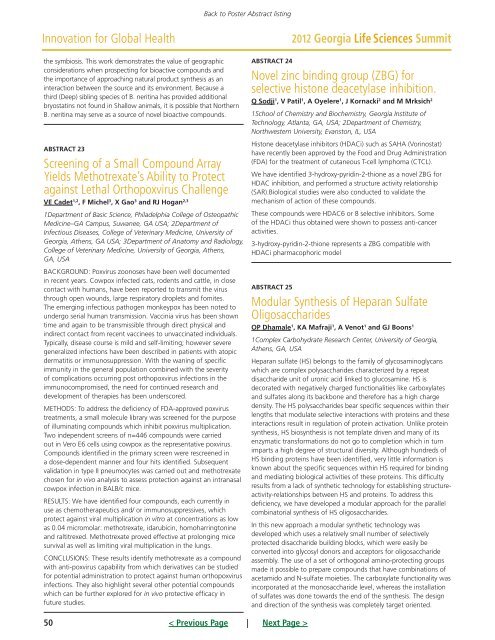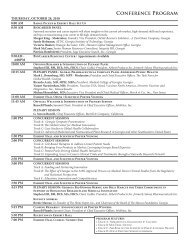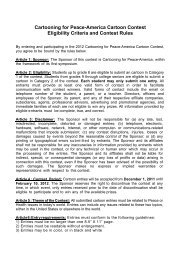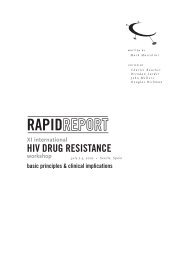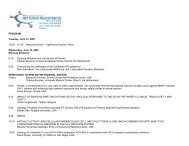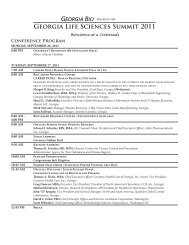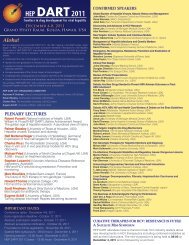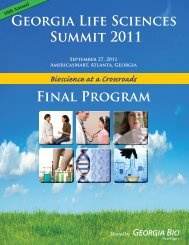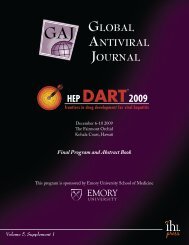Georgia Life Sciences Summit - Informed Horizons, LLC
Georgia Life Sciences Summit - Informed Horizons, LLC
Georgia Life Sciences Summit - Informed Horizons, LLC
You also want an ePaper? Increase the reach of your titles
YUMPU automatically turns print PDFs into web optimized ePapers that Google loves.
Back to Poster Abstract listing<br />
Innovation for Global Health<br />
the symbiosis. This work demonstrates the value of geographic<br />
considerations when prospecting for bioactive compounds and<br />
the importance of approaching natural product synthesis as an<br />
interaction between the source and its environment. Because a<br />
third (Deep) sibling species of B. neritina has provided additional<br />
bryostatins not found in Shallow animals, it is possible that Northern<br />
B. neritina may serve as a source of novel bioactive compounds.<br />
ABSTRACT 23<br />
Screening of a Small Compound Array<br />
Yields Methotrexate’s Ability to Protect<br />
against Lethal Orthopoxvirus Challenge<br />
VE Cadet 1,2 , F Michel 3 , X Gao 3 and RJ Hogan 2,3<br />
1Department of Basic Science, Philadelphia College of Osteopathic<br />
Medicine–GA Campus, Suwanee, GA USA; 2Department of<br />
Infectious Diseases, College of Veterinary Medicine, University of<br />
<strong>Georgia</strong>, Athens, GA USA; 3Department of Anatomy and Radiology,<br />
College of Veterinary Medicine, University of <strong>Georgia</strong>, Athens,<br />
GA, USA<br />
BACKGROUND: Poxvirus zoonoses have been well documented<br />
in recent years. Cowpox infected cats, rodents and cattle, in close<br />
contact with humans, have been reported to transmit the virus<br />
through open wounds, large respiratory droplets and fomites.<br />
The emerging infectious pathogen monkeypox has been noted to<br />
undergo serial human transmission. Vaccinia virus has been shown<br />
time and again to be transmissible through direct physical and<br />
indirect contact from recent vaccinees to unvaccinated individuals.<br />
Typically, disease course is mild and self-limiting; however severe<br />
generalized infections have been described in patients with atopic<br />
dermatitis or immunosuppression. With the waning of specific<br />
immunity in the general population combined with the severity<br />
of complications occurring post orthopoxvirus infections in the<br />
immunocompromised, the need for continued research and<br />
development of therapies has been underscored.<br />
METHODS: To address the deficiency of FDA-approved poxvirus<br />
treatments, a small molecule library was screened for the purpose<br />
of illuminating compounds which inhibit poxvirus multiplication.<br />
Two independent screens of n=446 compounds were carried<br />
out in Vero E6 cells using cowpox as the representative poxvirus.<br />
Compounds identified in the primary screen were rescreened in<br />
a dose-dependent manner and four hits identified. Subsequent<br />
validation in type II pneumocytes was carried out and methotrexate<br />
chosen for in vivo analysis to assess protection against an intranasal<br />
cowpox infection in BALB/c mice.<br />
RESULTS: We have identified four compounds, each currently in<br />
use as chemotherapeutics and/ or immunosuppressives, which<br />
protect against viral multiplication in vitro at concentrations as low<br />
as 0.04 micromolar: methotrexate, idarubicin, homoharringtonine<br />
and raltitrexed. Methotrexate proved effective at prolonging mice<br />
survival as well as limiting viral multiplication in the lungs.<br />
CONCLUSIONS: These results identify methotrexate as a compound<br />
with anti-poxvirus capability from which derivatives can be studied<br />
for potential administration to protect against human orthopoxvirus<br />
infections. They also highlight several other potential compounds<br />
which can be further explored for in vivo protective efficacy in<br />
future studies.<br />
2012 <strong>Georgia</strong> <strong>Life</strong> <strong>Sciences</strong> <strong>Summit</strong><br />
ABSTRACT 24<br />
Novel zinc binding group (ZBG) for<br />
selective histone deacetylase inhibition.<br />
Q Sodji 1 , V Patil 1 , A Oyelere 1 , J Kornacki 2 and M Mrksich 2<br />
1School of Chemistry and Biochemistry, <strong>Georgia</strong> Institute of<br />
Technology, Atlanta, GA, USA; 2Department of Chemistry,<br />
Northwestern University, Evanston, IL, USA<br />
Histone deacetylase inhibitors (HDACi) such as SAHA (Vorinostat)<br />
have recently been approved by the Food and Drug Administration<br />
(FDA) for the treatment of cutaneous T-cell lymphoma (CTCL).<br />
We have identified 3-hydroxy-pyridin-2-thione as a novel ZBG for<br />
HDAC inhibition, and performed a structure activity relationship<br />
(SAR).Biological studies were also conducted to validate the<br />
mechanism of action of these compounds.<br />
These compounds were HDAC6 or 8 selective inhibitors. Some<br />
of the HDACi thus obtained were shown to possess anti-cancer<br />
activities.<br />
3-hydroxy-pyridin-2-thione represents a ZBG compatible with<br />
HDACi pharmacophoric model<br />
ABSTRACT 25<br />
Modular Synthesis of Heparan Sulfate<br />
Oligosaccharides<br />
OP Dhamale 1 , KA Mafraji 1 , A Venot 1 and GJ Boons 1<br />
1Complex Carbohydrate Research Center, University of <strong>Georgia</strong>,<br />
Athens, GA, USA<br />
Heparan sulfate (HS) belongs to the family of glycosaminoglycans<br />
which are complex polysaccharides characterized by a repeat<br />
disaccharide unit of uronic acid linked to glucosamine. HS is<br />
decorated with negatively charged functionalities like carboxylates<br />
and sulfates along its backbone and therefore has a high charge<br />
density. The HS polysaccharides bear specific sequences within their<br />
lengths that modulate selective interactions with proteins and these<br />
interactions result in regulation of protein activation. Unlike protein<br />
synthesis, HS biosynthesis is not template driven and many of its<br />
enzymatic transformations do not go to completion which in turn<br />
imparts a high degree of structural diversity. Although hundreds of<br />
HS binding proteins have been identified, very little information is<br />
known about the specific sequences within HS required for binding<br />
and mediating biological activities of these proteins. This difficulty<br />
results from a lack of synthetic technology for establishing structureactivity-relationships<br />
between HS and proteins. To address this<br />
deficiency, we have developed a modular approach for the parallel<br />
combinatorial synthesis of HS oligosaccharides.<br />
In this new approach a modular synthetic technology was<br />
developed which uses a relatively small number of selectively<br />
protected disaccharide building blocks, which were easily be<br />
converted into glycosyl donors and acceptors for oligosaccharide<br />
assembly. The use of a set of orthogonal amino-protecting groups<br />
made it possible to prepare compounds that have combinations of<br />
acetamido and N-sulfate moieties. The carboxylate functionality was<br />
incorporated at the monosaccharide level, whereas the installation<br />
of sulfates was done towards the end of the synthesis. The design<br />
and direction of the synthesis was completely target oriented.<br />
50<br />
< Previous Page | Next Page >


